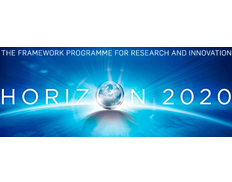Share
Print

Applicants should note that a Revised SJU Model Grant Agreement has been published under the "Additional documents" section.
Applicants should note that the Final version of the FAQ (v2.2) has been published under the "Call documents" section. No further questions related to this Call will be answered
Applicants should note that a third version of the FAQ (v2.1) has been published under the "Call documents" section
Applicants should note that an updated version of the FAQ (v2.0) has been published under the "Call documents" section
Applicants should note that:
- The FAQ table answering to the received questions has been added under the "Call documents" section
- The maximum duration for the Grants is 24 months, as specified in the Financing Decision. The “ER First Call for Research Projects” document has been updated accordingly.
- The “Project Execution Guidance for SESAR 2020 Exploratory Research” document, providing guidance on Chapter 6 of the “ER First Call for Research Projects”, as well as the “SJU Self-Assessment Form”, can be found on the Topics Conditions and Documentation page of each Topic
04 June 2015 19:43
The submission session is now available for: Sesar-08-2015(SESAR-RIA),
Applicants should note that:
- The FAQ table answering to the received questions has been added under the "Call documents" section
- The maximum duration for the Grants is 24 months, as specified in the Financing Decision. The “ER First Call for Research Projects” document has been updated accordingly.
- The “Project Execution Guidance for SESAR 2020 Exploratory Research” document, (expanding Chapter 6 of the “ER First Call for Research Projects”), the “SESAR 2020 Programme Execution Introduction” document (providing wider context on SESAR 2020) and the “SJU Self-Assessment Form” can be found on the Topics Conditions and Documentation page of each Topic
27 March 2015 10:57 The submission session is now available for: Sesar-08-2015(SESAR-RIA)
| Topic identifier: | Sesar-08-2015 | ||
| Publication date: | 19 March 2015 | ||
| Types of action: | SESAR-RIA Research and Innovation action | ||
| DeadlineModel: Opening date: |
single-stage 24 March 2015 |
Deadline: | 25 June 2015 17:00:00 |
| Time Zone : (Brussels time) | |||
Specific challenge: Communication, navigation and surveillance (CNS) systems are the building blocks on which air traffic management operates. Despite many activities in the CNS domain there remain a number of areas where more fundamental research is needed.
The use, or adaptation, of new technologies being developed outside ATM to support ATM CNS needs should be considered including analysis of the safety, performance and security implications for the ATM system. Technology lead times in ATM along with certification requirements should be taken into account. More flexible system architectures for ground and airborne systems should be considered in this context (eg building on integrated modular avionics and an open interface approach to ground system development) to help unlock us from legacy technologies. Research projects are expected to perform an assessment of the benefits and risks from an integrated CNS infrastructure in particular with regard to redundancy and performance needs.
Scope: The full range of research that could be covered in this topic is broad and topics mentioned here are indicative. Projects may target implementation in the mid-term or could address timeframes up to those of the Flightpath 2050 vision document.
Many aspects of CNS are currently characterised by lack of integration: multiple technologies are used where it could be possible to merge into one, both within and across domains. This has the potential to generate substantial cost savings and efficiencies and, crucially, improvements in security. Studies could address the integration, interoperability and openness of such an approach for the long term, exploiting synergies, reducing costs and optimising spectrum usage. Furthermore, spectrum is a limited natural resource and increasing demands are putting aviation under pressure. Research could show how the industry can move towards a more spectrum-efficient approach to CNS with a holistic view of the full life-cycle.
In the communications domain future innovative data-link technologies (e.g. high-bandwidth) for ATM going well beyond current ATM developments and taking into account research and development outside ATM should be studied. This should include technology options suitable for the airport domain, continental airspace and oceanic and remote areas (including high latitudes and polar region). Research proposals are expected to address the research issues related to resistance/prevention to jamming and spoofing.
In the navigation domain innovative research ideas, concepts and technologies for small aircraft are need, as a suitable back-up/continuity system for GNSS (e.g. affordable inertial systems and use of ‘other’ signals (signals of opportunity) for navigation integrity. The options for advanced alternative PNT systems should also be considered. Furthermore the transition from barometric to geometric (GPS) altitude for collision avoidance issues can be studied. In addition the re-examination of both vertical and horizontal separation practices are needed in the light of improved navigation accuracy (better than declared RNP performance).
In surveillance domain research projects can address the Surveillance Performance analysis and Quality of Services (QoS) leading to a “performance based surveillance” approach that facilitates adoption of new technologies. Furthermore, research ideas are needed in the assessment of future role of non-cooperative technologies with global coverage (e.g. satellite-based, etc.) for ATM.
Expected impact: This research will demonstrate and quantify the potential for CNS developments to improve the efficiency and performance of the ATM system at many levels.
Successful research in this topic will have the potential to generate high positive benefits for ATM in terms of resource efficient and fit-for-purpose CNS capabilities as well as improvements in security.
Type of action: SESAR2020 Research and Innovation Action.
Further conditions related to this topic are provided in the Technical Specification of the Call.
